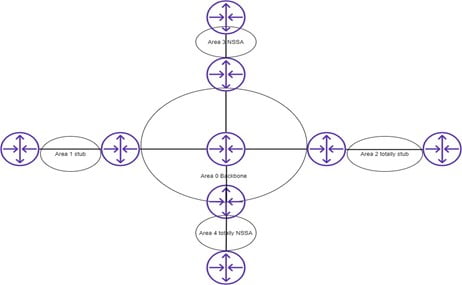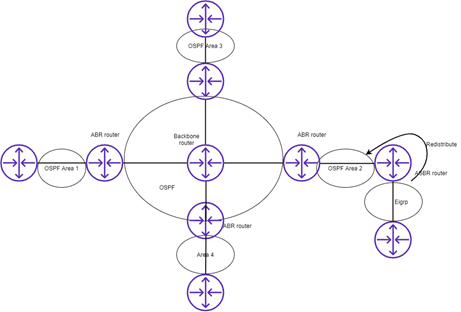What are the different Areas in OSPF – Open Shortest Path First?
An Area type of ospf is a logical group of devices within a single administration. Cisco recommends that the single area should not have more than 50 routers. It has a 32 bit long ID and area-id can be represented in decimal number or ipv4 format
Area type of ospf.

WHY DO WE USE AREA TYPE IN OSPF?
We use area type for filtering LSA.
There are five types of Area in OSPF
- Standard Area
- Stub Area
- Totally stub
- NSSA Area
- Totally NSSA Area
Standard Area
By default, all areas are standard area.
Stub Area
It is used to filter types5 LSA and Type4 LSA or to filter external routers after filtering type5 and type4 LSA. It automatically generates the default route and the default route is advertised by ABR. stub feature is run on both sides means ABR and all other routers of that area. We can’t configure area 0 as a stub area. Stubs are not allowed a virtual link. The stub area is not allowed ASBR router so we can’t configure the stub area near the ASBR router.
Totally stub
It filters Lsa3,4,5 or external as well as inter-area routes after that it automatically generates the default route. It is implemented only on the ABR router.
NSSA Area
It stands for NOT-SO-STUB AREA, it is used to allow an asbr to send external routes through stub area using type7 LSA. It is also filtered LSA4,5 but redistribution is allowed. ASBR router will generate type 7 LSA after that ABR will convert type 7 LSA back to type5 LSA. The default route will be manually configured.
Totally NSSA
It is also filtered LSA3,4,5 now if I am to talk about the default route it will automatically generate and implement only on the ABR router. It is also allowed redistribution and default routes to originate by ABR.
Routers Type In OSPF
- Backbone router
- Internal router
- Area border router (ABR)
- Autonomous system boundary router (ASBR)

Backbone router: – A router has all interfaces in Area 0 and in that area, we can transit area.
Internal router: – A router that has all interfaces in a regular Area is called an internal router.
Area Border router: – a router that has at least one interface in the backbone area and one in the regular area. we create ABR for dividing databases into a different areas. An ABR will keep multiple Area’s databases in memory. It can send routing information to a different area but not send a database.
ASBR autonomous system border router: -it is used to connect different routing protocols with ospf or redistribute eigrp into ospf. It is used to exchange routing information in ospf and different protocols.
What Is the Requirement To Form An OSPF Neighborship?
If you want form ospf neighborship, some couple of things must match. Like:-
- area-id must match
- timer must match
- Mtu size must match
- router-id must not match
- network type should match
- sub netmask must match
- authentication must match
What Is An LSA?
A router will always keep its route information in its database in the form of LSA, when any update will go from one device to another device to another device it will go in the form of LSA.
What are the different types of LSA
There are normally seven types of LSA
- type1 LSA (Router LSA)
- type2 LSA (network LSA)
- type3 LSA (summary LSA)
- type4 LSA (ASBR Summary LSA)
- type5 LSA (External LSA)
- type6 LSA (Group Membership LSA)
- type7 LSA (NSSA LSA)
So, in the above blog, we learned about what is an area in Ospf, types of routers. We also learned about LSA types. We will learn in next part 3 about the working of LSA.
Zindagi Technologies Pvt. Ltd. is an IT consultancy and professional services organization. We have expertise in planning, designing, and deployment of Network and Security technologies, large-scale data centers, Private/Public/Hybrid cloud solutions. For more details, we are available for you, give us a call on +919773973971 or reach us at Zindagi Technologies.
Author
Anuj Kumar
Associate Consultant
